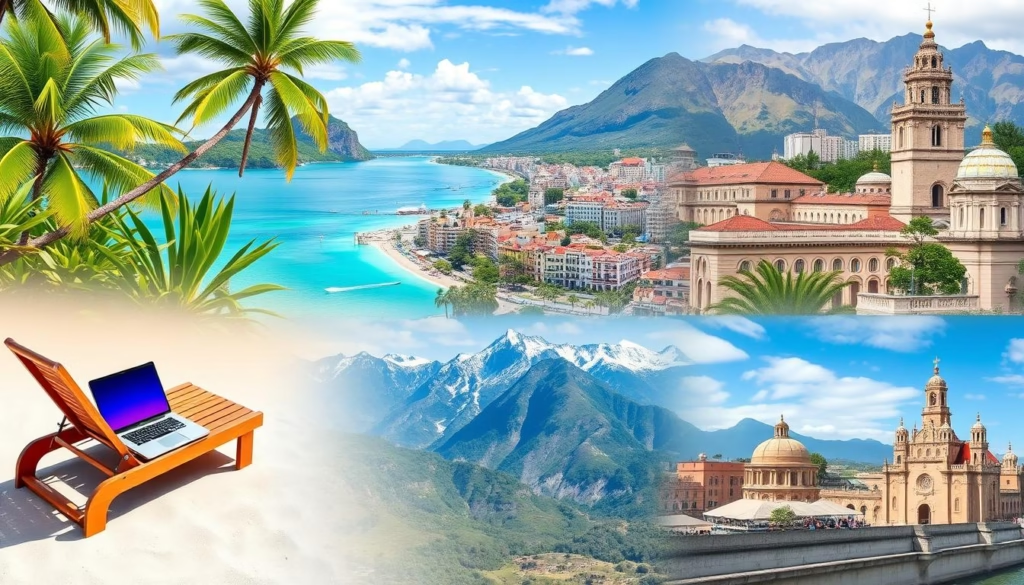Digital Nomad Visa: How to Apply and What You Need to Know
December 28, 2024 | by m33559844@gmail.com

In today’s fast-paced world, working while exploring foreign cultures and landscapes is now possible. Imagine enjoying a coffee at a seaside café in Portugal, with your laptop open and the ocean waves in the background. This is not just a dream; it’s a reality thanks to the Digital Nomad Visa.
This visa lets location-independent professionals work and travel. With remote work on the rise, this visa has become very popular. It allows people to live a lifestyle once thought impossible. The cost of getting a remote work visa varies, from $200 to $2,000, and even up to $3,000 for families in some places1.
This path offers flexibility and adventure, enriching both work and personal lives. It creates a unique mix of experiences that make life more fulfilling.
The world is more connected than ever, and work is changing fast. The Digital Nomad Visa doesn’t just let you work remotely. It changes how we see work, lifestyle, and travel. It invites professionals to explore new places while staying connected to the global economy.
Key Takeaways
- The Digital Nomad Visa allows remote workers to live and work abroad legally.
- Costs for the visa can range from $200 to $2,000, with some applications significantly higher.
- 91% of digital nomad programs were successfully launched post-pandemic2.
- Requirements often include proof of income and employment that can be performed remotely.
- Many countries offer extended validity periods of up to five years for the visa.
- 65 countries currently provide Digital Nomad Visas, varying in names and requirements.
If you’re ready to kickstart your travel journey with ease and exclusive savings, book your first trip now! Visit Trip.com using this special promotion link and register to reserve tickets, accommodation, and more. Don’t miss out on these incredible travel deals tailored for first-time travelers—start planning today!
What is a Digital Nomad Visa?
A Digital Nomad Visa lets people work remotely in a foreign country legally. It’s for those who want to work and travel at the same time. This visa allows a temporary stay in many international places.
Definition and Purpose
This visa helps remote workers explore new cultures and places. Over 50 countries offer such visas, with new ones in places like Kenya3. The length of these visas varies, from six months to a year, with some countries allowing renewals up to five years3.
This makes the digital nomad visa great for those who want to travel long-term while working remotely.
Differences from Traditional Visas
Digital nomad visas differ from traditional visas in purpose and rules. Traditional visas usually don’t let you work and are for short stays. Digital nomad visas, on the other hand, let you work for foreign companies in the host country4.
Unlike some traditional visas, digital nomad visas focus on remote workers. They help maintain professional duties from different locations.
Eligibility Criteria for a Digital Nomad Visa
To start working remotely in a new country, knowing the visa rules is key. Each country has its own set of rules for digital nomad visas. This part will cover the main age and income rules you need to know.
Age Requirements
Mostly, you must be 18 or older to get a digital nomad visa. This rule makes sure you can legally follow the visa rules of the country you visit. Some places might have different age limits, but it’s not the same everywhere.
Income and Employment Criteria
The money you make is a big part of getting a digital nomad visa. You usually need to show you have a steady income that meets the country’s standards. For example, in 2024, some countries like Greece want you to make at least €3,500 a month. Portugal asks for €3,040 for long stays and €3,280 for short ones56. Dubai wants $3,500 a month, and $5,000 for its Virtual Working Program5.
You also need to show you’re employed, like with a remote work contract or proof of income. If you don’t meet these money and job rules, your visa might not get approved. This is a common problem5.
| Country | Minimum Monthly Income Requirement | Application Fee |
|---|---|---|
| Greece | €3,500 | Varies |
| Portugal | €3,040 (long-term) €3,280 (temporary) | Varies |
| Dubai | $3,500 (general) $5,000 (Virtual Working Program) | Varies |
| Costa Rica | $2,500 | $190 |
| Barbados | $3,500 | $2,000 |
Benefits of a Digital Nomad Visa
A Digital Nomad Visa offers many perks for those who love to travel and work remotely. It lets you stay in a new country for up to two years, depending on the rules7. This long stay allows you to dive deep into local cultures and keep working, making your experience richer.
Extended Stay in Host Countries
Unlike tourist visas, Digital Nomad Visas give you more time. They last longer, which means less disruption to your work and life. This is a big plus for those who work remotely.
Legality of Remote Work
Having a Digital Nomad Visa also makes remote work legal. It avoids the legal issues that come with using tourist visas for work. About 37% of companies let their employees work from abroad8. Around 70% of these companies need the right visa for remote work8.
Best Countries for Digital Nomads
Remote work is becoming more popular, leading to many countries welcoming digital nomads. These best countries for digital nomads are found in Europe, Asia, and the Americas. Each offers its own benefits and rules for remote workers. You can choose from bustling cities to peaceful landscapes.
Popular Options in Europe
In Europe, Portugal, Spain, and Croatia stand out for digital nomads. Portugal asks for a monthly income of $2,950 for its Temporary-Stay Visa9. Spain needs at least $2,215 a month and costs $265 for the visa9. Croatia offers its Digital Nomad Residence Permit for $73, with a minimum income of $2,6589.
Attractive Destinations in Asia
Asia is a hit with digital nomads for its low cost of living and rich culture. Thailand lets you in with $16,000 in savings, no monthly income needed10. It’s perfect for those who want to work and play in a beautiful place.
Emerging Locations in the Americas
In the Americas, Mexico and Costa Rica are gaining popularity. Costa Rica requires $3,000 a month and a $90 visa fee10. Mexico is also becoming a favorite with its lively culture and warm weather.

If you’re ready to kickstart your travel journey with ease and exclusive savings, book your first trip now! Visit Trip.com using this special promotion link and register to reserve tickets, accommodation, and more. Don’t miss out on these incredible travel deals tailored for first-time travelers—start planning today!
| Country | Visa Cost | Minimum Monthly Income | Key Features |
|---|---|---|---|
| Portugal | $0 | $2,950 | Friendly expat community, lively culture |
| Spain | $265 | $2,215 | Rich history and vibrant cities |
| Croatia | $73 | $2,658 | Stunning coastlines and national parks |
| Thailand | $400 | $0 (savings $16,000) | Affordable living and beautiful beaches |
| Costa Rica | $90 | $3,000 | Biodiversity and eco-tourism |
These countries are top picks for digital nomads, each with its own lifestyle and work conditions. They cater to the needs of remote workers.
Digital Nomad Visa vs. Tourist Visa
Choosing between a digital nomad visa and a tourist visa is key for those wanting to work abroad. Knowing the advantages and disadvantages of tourist visa and digital nomad visa helps make the right choice.
Pros and Cons of Each Option
Digital nomad visas have many benefits over tourist visas. They let you legally work in the host country, which is great for remote workers. Tourist visas, on the other hand, are for fun only and don’t allow work.
Tourist visas usually last about 90 days, while digital nomad visas can last from 6 months to 2 years. This makes digital nomad visas better for long-term stays1112.
But, tourist visas have their own advantages. They’re easier and faster to get, perfect for short trips. Yet, they limit access to local services and don’t let you live in the host country long-term.
Duration and Flexibility
Digital nomad visas offer longer stays than tourist visas. While tourist visas last a few weeks to months, digital nomad visas can last up to a year or more in some places12. This makes them ideal for remote work.
Tourist visas don’t lead to residency, unlike digital nomad visas. Digital nomad visas can open doors to longer-term living in the host country.
| Aspect | Digital Nomad Visa | Tourist Visa |
|---|---|---|
| Duration of Stay | 6 months to 2 years | 90 days (typically) |
| Work Legality | Legal to work | No work allowed |
| Pathway to Residency | Can lead to residency | No pathway to residency |
| Application Process | More complex, longer processing times | Quicker, less complicated |
| Access to Local Services | Full access to local services | Limited access |
Deciding between a digital nomad visa vs tourist visa depends on your needs and work type. Knowing the basics helps navigate international living1112.
Application Process for Digital Nomad Visa
The process for getting a digital nomad visa changes with each country. Knowing what you need is key. Follow this step-by-step guide for digital nomad visa to make getting your visa easier.
Step-by-Step Guide
- First, check if you qualify. You must work for a foreign company no more than 20% of your time in Spain13.
- Next, collect your documents. You’ll need a valid passport with at least one year left and two blank pages13.
- Then, show you have enough money. You need at least 200% of Spain’s monthly minimum wage13.
- Get health insurance that covers Spain’s public health system13.
- Get a criminal record certificate from the last two years. Also, a responsible declaration for the last five years13.
- Submit your application and documents at the embassy or consulate.
Common Application Pitfalls
There are common mistakes to avoid:
- Applying with missing information can cause delays.
- Incorrect information on forms can confuse the review team.
- Not meeting financial requirements can block your application.

Knowing these mistakes can help you avoid them. This will make getting your digital nomad visa smoother13.
What Documents Are Required?
Getting a digital nomad visa needs you to submit many important documents. The documents required for digital nomad visa can change from country to country. It’s key to know the usual documents and any local special needs for a smooth application.
Typical Documentation Needed
Applicants usually need to show a few basic documents to meet the documentation for application rules. These include:
- Visa application form
- Valid passport
- Recent identity photographs
- Proof of health insurance
- Evidence of financial income
- Proof you can work remotely, like a work contract or business registration
For example, Spain asks for a clean criminal record from the last five years and a monthly income of €2,400 for one person or €4,200 for a family of two for its digital nomad visa14. Brazil wants a monthly income of USD 1,500 or savings of at least USD 18,000, plus identity papers15.
Local Variations in Document Requirements
Requirements for documents can change a lot between countries. Sometimes, you might need to show bank statements from the last three to six months16. Portugal asks for annual tax returns, while others don’t have a specific income rule but want proof you can support yourself with bank statements. You might need to notarize or apostille bank statements, depending on the country’s rules.
| Country | Minimum Income Requirement | Processing Time | Special Document Considerations |
|---|---|---|---|
| Spain | €2,400/month | 15-45 days | Clean criminal record, proof of qualifications |
| Brazil | USD 1,500/month | 60 days | Bank statements, immigration lawyer advice recommended |
| Portugal | Varies | Not specified | Annual tax returns required |
Knowing these details can make your application smoother and boost your chances of getting approved141516.
Tax Implications for Digital Nomads
Digital nomads face unique tax challenges based on where they live and how long they stay. Countries often consider them tax residents if they spend more than 183 days there. This means they must follow local tax laws and file tax returns.
Not all countries tax their residents the same way. Over 130 countries tax based on where you live, while places like Alaska and Florida don’t tax state income17.

If you’re ready to kickstart your travel journey with ease and exclusive savings, book your first trip now! Visit Trip.com using this special promotion link and register to reserve tickets, accommodation, and more. Don’t miss out on these incredible travel deals tailored for first-time travelers—start planning today!
Understanding Tax Residency
Being a tax resident for digital nomads depends on several things. It includes how much time they spend in a country and their job status. The Foreign Earned Income Tax Exclusion (FEIE) helps U.S. citizens abroad avoid some taxes.
They can exclude up to $126,500 of income from U.S. taxes if they meet certain conditions. These include being outside the U.S. for over 330 days in a year1718. If they don’t meet these rules, they could face complex tax issues.
Potential Tax Liabilities
Digital nomads must file a U.S. tax return if they earn enough, no matter where they are17. They also have to pay a 15.3% self-employment tax for Social Security and Medicare if they work for themselves. But, they can get some relief with the Foreign Tax Credit.
This credit lets them deduct foreign taxes they’ve already paid17.
How Long is a Digital Nomad Visa Valid?
The length of a digital nomad visa varies by country. Most are good for one to two years. For instance, Spain’s visas last one year if applied for outside the country. But, they can be extended to three years if applied for in Spain19.
The Czech Republic gives freelancers a one-year visa that can be renewed20.
Typical Length of Stay
Most digital nomad visas last about a year. Many countries let you extend it if you keep meeting the requirements21. This means you can stay longer and keep working while enjoying your location.
In Estonia, you need to make at least €4,500 a month to get the visa21. This shows the importance of being financially stable while living there.
Renewal Options
To renew your visa, you’ll need to update your application and show you’re financially stable and employed. In the Czech Republic, following the application guidelines is key for renewals20. Renewals usually last another year, as long as you meet the conditions.
Different countries have different rules, like a minimum income of around €24,789 a year for some visas20. So, it’s important to know your country’s renewal rules to stay compliant and avoid problems.
Conclusion
The Digital Nomad Visa is a great chance for remote workers to travel and work legally. It’s important to know how to apply, what you need, and the benefits. Countries like Estonia, Portugal, and Thailand offer great perks for digital nomads, like long stays and good lifestyles222324.
To become a digital nomad, you need to meet certain income and document needs. Countries see the economic benefits of digital nomads and offer many incentives24.
The Best Countries for Digital Nomads Explore to Live . Choosing the Digital Nomad Visa lifestyle means more than just traveling. It’s about diving into new cultures and keeping up with your career in different places. With the right steps, this visa can lead to a rewarding and exciting life.
FAQ
What exactly is a Digital Nomad Visa?
A Digital Nomad Visa lets remote workers live and work in a foreign country for a set time. They can do this while working for employers or clients outside that country.
How does a Digital Nomad Visa differ from a traditional tourist visa?
Unlike tourist visas, which limit work and stay short, a Digital Nomad Visa lets you work legally for longer. You can stay in a country for months or even years.
What are the typical requirements to apply for a Digital Nomad Visa?
You must be 18 or older and show you have a steady income. This income must meet the host country’s standards. You’ll need to prove you work remotely, like with contracts or regular income.
What are the main benefits of a Digital Nomad Visa?
The big perks are being able to live and work in a new country for a long time. You can earn money and enjoy the local culture and lifestyle.
Which countries offer Digital Nomad Visas?
Countries like Portugal, Spain, Croatia, Thailand, Bali, Mexico, and Argentina offer these visas. They’re popular with digital nomads for their good conditions and lively cultures.
How does the application process for a Digital Nomad Visa work?
First, fill out a visa application form. Then, gather documents like proof of employment, financial stability, and health insurance. Submit these at the embassy or consulate.
What common mistakes should applicants avoid when applying for a Digital Nomad Visa?
Don’t make your application incomplete or give wrong information. Also, make sure you meet the financial requirements. These mistakes can cause your visa to be rejected.
What documentation is usually required to apply for a Digital Nomad Visa?
You’ll need a visa application form, a valid passport, and identity photos. Also, provide proof of health insurance, financial income, and remote work capabilities, like a work contract or business registration.
What are the tax implications for digital nomads living in a foreign country?
Taxes can change based on how long you stay. Some countries might tax you as a resident if you stay over 183 days. Others might not tax foreign income.
How long is a Digital Nomad Visa typically valid?
These visas usually last one to two years. Many countries let you extend it if you keep meeting the requirements.
What is the renewal process for a Digital Nomad Visa?
To renew, you’ll need to apply again. Show that you continue to have financial income and employment. You might also need new documents from the host country’s immigration.
RELATED POSTS
View all



